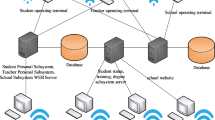Abstract
With the rapid development of information technology, physical education information management system has become an important part of modern education. However, the traditional physical education information management system has some problems in optical communication technology, such as bandwidth limitation and slow transmission speed, which affect the performance and effect of the system. This paper aims to improve the application of optical communication technology in physical education teaching information management system by using machine learning algorithm, and improve the performance and effect of the system. This paper collects the relevant data of PE teaching information management system, and carries on the pre-processing and feature extraction. The appropriate machine learning algorithm was then selected to train and optimize the model and applied to optical communication technology. The new system has higher bandwidth and transmission speed, can process and transmit data faster, and improve the teaching effect.





Similar content being viewed by others
Data availability
The data will be available upon request.
References
Alam, A., Mohanty, A., Alam, S.: Anthropology of education: discourses and dilemmas in analysis of educational patterns and cultural configurations towards pursuit of quality education. Palarch’s J. Archaeol. Egypt/egyptol. Netherlands 17(9), 7893–7924 (2020)
Block, M.E., Hutzler, Y., Barak, S., Klavina, A.: Creation and validation of the self-efficacy instrument for physical education teacher education majors toward inclusion. Adapt. Phys. Activ. Q. 30(2), 184–205 (2013)
Chen, D.: Application analysis of physical fitness test performance management based on improved ant colony algorithm. Tobacco Regulat. Sci. 7(5), 1991–1999 (2021)
Chun, C., Yin, W.Z.: Mathematical statistics-based university students’ physical health conditions and teaching strategies study. Eurasia J. Math. Sci. Technol. Educ. 13(10), 7077–7088 (2017)
Debelee, T.G., Schwenker, F., Rahimeto, S., Yohannes, D.: Evaluation of modified adaptive k-means segmentation algorithm. Comput. Visual Media 5(4), 2 (2019)
Elnour, M., Fadli, F., Himeur, Y., et al.: Performance and energy optimization of building automation and management systems: Towards smart sustainable carbon-neutral sports facilities. Renew. Sustain. Energy Rev. 162, 112401 (2022)
Ho, T.W., Tsai, H.H., Lai, J.F., et al.: Physical fitness cognition, assessment, and promotion: a cross-sectional study in Taiwan. PLoS ONE 15(10), e0240137 (2020)
Jamshid, R.D., Mukhiddin Ugli, K.A., Shafoat o’g’li, I.S., Tulakov, U.: Development of the digital economy in Uzbekistan as a key factor of economic growth and increase of living standards of the population. Int. J. Appl. Res. 6(6), 30–33 (2020)
Kamruzzaman, M.M., Alanazi, S., Alruwaili, M., et al.: Fuzzy-assisted machine learning framework for the fog-computing system in remote healthcare monitoring. Measurement 195, 111085 (2022)
Nugroho, H., Gontara, S.Y., Angga, P.D., Jariono, G., Maghribi, I.L.: Quality of physical condition of youth pencak silat athletes reviewed from speed, power, and strength. Kinestetik : J. Ilmiah Pendidikan Jasmani 5(1), 154–162 (2021). https://doi.org/10.33369/jk.v5i1.14376
Pan, C.: Design of sports course management system based on Internet of Things and FPGA system. Microprocess. Microsyst. 80, 103357 (2021)
Pelizza, A.: Towards a sociomaterial approach to inter-organizational boundaries: how information systems elicit relevant knowledge in government outsourcing. J. Inf. Technol. 36(2), 94–108 (2021)
Sloan, R., Visentini-Scarzanella, M., Sawada, S., et al.: Estimating cardiorespiratory fitness without exercise testing or physical activity status in healthy adults: regression model development and validation. JMIR Public Health Surveill. 8(7), e34717 (2022)
Ter Steege, R.W.F., Kolkman, J.J.: The pathophysiology and management of gastrointestinal symptoms during physical exercise, and the role of splanchnic blood flow. Aliment. Pharmacol. Ther. 35(5), 516–528 (2012)
Wang, C., Yu, C., Guo, W., et al.: Identification of typical sub-health state of traction battery based on a data-driven approach. Batteries 8(7), 65 (2022)
Funding
The authors have not disclosed any funding.
Author information
Authors and Affiliations
Contributions
Qingwen Zhai has done the first version, Xiao Chen has done the simulations. All authors have contributed to the paper’s analysis, discussion, writing, and revision.
Corresponding author
Ethics declarations
Conflict of interest
The authors declare that they have no competing interests.
Ethical approval
Not applicable.
Additional information
Publisher's Note
Springer Nature remains neutral with regard to jurisdictional claims in published maps and institutional affiliations.
Rights and permissions
Springer Nature or its licensor (e.g. a society or other partner) holds exclusive rights to this article under a publishing agreement with the author(s) or other rightsholder(s); author self-archiving of the accepted manuscript version of this article is solely governed by the terms of such publishing agreement and applicable law.
About this article
Cite this article
Zhai, Q., Chen, X. Design and application of optical communication technology based on machine learning algorithms in physical education teaching information management system. Opt Quant Electron 56, 111 (2024). https://doi.org/10.1007/s11082-023-05717-5
Received:
Accepted:
Published:
DOI: https://doi.org/10.1007/s11082-023-05717-5




